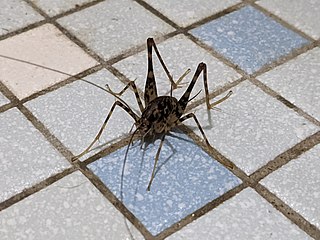
The orthopteran family Rhaphidophoridae of the suborder Ensifera has a worldwide distribution. Common names for these insects include cave crickets, camel crickets, spider crickets, and sand treaders. Those occurring in New Zealand are typically referred to as jumping or cave wētā. Most are found in forest environments or within caves, animal burrows, cellars, under stones, or in wood or similar environments. All species are flightless and nocturnal, usually with long antennae and legs. More than 500 species of Rhaphidophoridae are described.
Dendroplectron aucklandensis the Auckland Island wētā, is a cave wētā in the family Rhaphidophoridae, the only member of the genus Dendroplectron. It is endemic to the subantarctic Auckland Islands of New Zealand.

Isoplectron is a genus of cave wētā in the family Rhaphidophoridae with three species currently recognised. The genus is endemic to New Zealand and distributed throughout the country.
Insulanoplectron is a genus of cave wētā in the family Rhaphidophoridae, with just one species: the Snares Island Wētā. Insulanoplectron spinosum is endemic to the subantartic Snares Island of New Zealand, where it is considered to be naturally uncommon. Wētā are nocturnal crickets found all around the world. During the day on the Snares, wētā can be found hiding in seabird burrows.

Novoplectron is a monotypic genus of cave wētā in the family Rhaphidophoridae, endemic to the Chatham Islands. Cave wētā are nocturnal, wingless crickets that occupy humid habitats. Novoplectron wētā generally live under stones and in burrows of seabirds, such as broad-billed prions, mutton birds and storm petrels.

Pleioplectron is a genus of cave wētā in the family Rhaphidophoridae, endemic to New Zealand. These wētā are fairly common at night among the leaf litter in native forest in the South Island of New Zealand. The species look very similar to species of Miotopus, another New Zealand endemic genus, recently resurrected.

Tasmanoplectron isolatum is a rare nocturnal species of cave cricket, and is the only species represented in the genus Tasmanoplectron, belonging to the family Rhaphidophoridae. In 1971, Aola M. Richards was first to describe this species in Tasmania, Australia, where its geographical distribution is restricted to. The genus is thought to have affinities with New Zealand fauna due to its marked differences from the other Australian Rhaphidophoridae.

Diestrammena is a 'camel' or 'cave-cricket' genus in the family Rhaphidophoridae. Species in the genus are native to Asia, including Japan.
Euhadenoecus insolitus, the mccluney cave cricket, is a species of camel cricket in the family Rhaphidophoridae. It is found in North America. E. insolitus regularly forage outside their cave habitat except in the winter. Different populations reproduce either through sexual reproduction or parthenogenesis.
Hadenoecus cumberlandicus, the Cumberland cave cricket, is a species of camel cricket in the family Rhaphidophoridae. It is found in North America.

Hadenoecini is a tribe of cave crickets in the family Rhaphidophoridae. There are two genera and nine described species. It is sometimes considered a synonym of the subfamily Dolichopodainae.

Dolichopoda is a genus of cave crickets in the tribe Dolichopodaini, subfamily Dolichopodainae. They are distributed in the Mediterranean basin in southern Europe and western Asia.

Wētā is the common name for a group of about 100 insect species in the families Anostostomatidae and Rhaphidophoridae endemic to New Zealand. They are giant flightless crickets, and some are among the heaviest insects in the world. Generally nocturnal, most small species are carnivores and scavengers while the larger species are herbivorous. Although some endemic birds likely prey on them, wētā are disproportionately preyed upon by introduced mammals, and some species are now critically endangered.
Dr Aola Mary Richards was a New Zealand entomologist specialising in the study of New Zealand and Australian cave crickets, or wētā (Rhaphidophoridae), and Australian ladybird beetles (Coccinellidae). She was the first New Zealand woman to gain a PhD in biology.
Dolichopoda paraskevi, the Cretan cave-cricket, is a species of cave cricket within the family Rhaphidophoridae. It endemic to Crete, where it is known to inhabit 4 caves on the eastern side of the island. The type locality of the species was collected in the Skotino Cave.

Dolichopoda azami, the Azam's cave-cricket, is a species of cave cricket within the family Rhaphidophoridae. The species distribution is in France in the Southern Alps and in Italy in Piedmont, Liguria and Lombardia, where it lives in various dark habitats that have stable temperatures and high humidity. Such habitats include rocky forests, caves, damaged bridges or aqueducts, and abandoned/disused buildings at elevations of 120 to 1,940 metres. It lives in these habitats during the day and is primarily active at night.
Cavernotettix is a genus of cave crickets in the family Rhaphidophoridae, in South-Eastern Australia and Tasmania. There are five species in the genus Cavernotettix. The genus was first described by New Zealand entomologist Aola Richards in 1966.
Parvotettix is an extant genus of cave cricket from the order Orthoptera in the family Rhaphidophoridae, endemic to Tasmania, Australia. The genus was established in 1968 by Aola Richards and contains six species she described. Parvotettix is a sister group to the subfamily Macropathinae, forming a paraphyletic Australian grouping.

Novotettix is a monotypic genus of cave cricket/wētā in the family Rhaphidophoridae endemic to south-east Australia.










